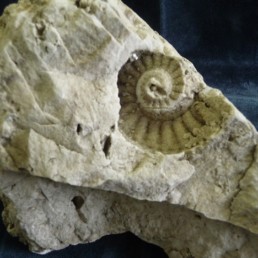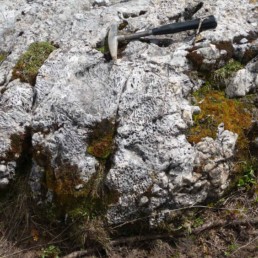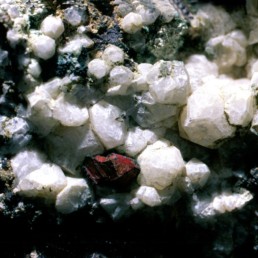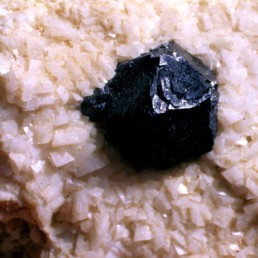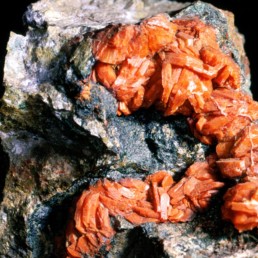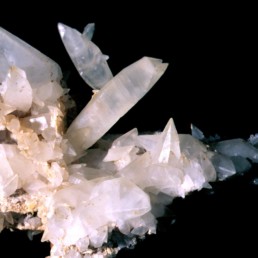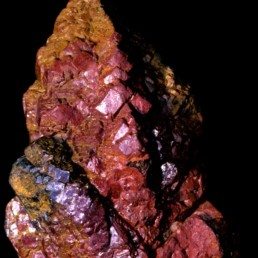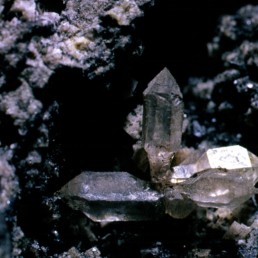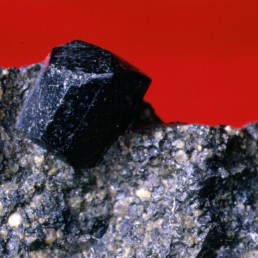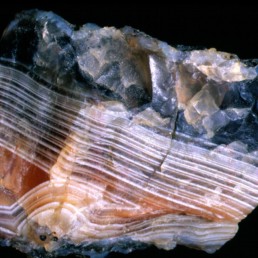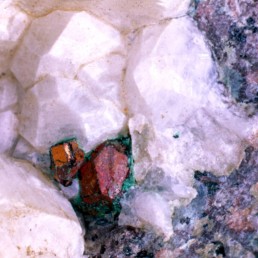Photos and texts are taken from "Dolomiti di Cristallo" by Danilo Giordano, GAMP editions
Val Imperina, Vallalta and Val San Lucano Mines
In the Agordino area, collecting minerals is very common. This activity has deep and distant roots. The development of more or less important local mining activities – which was followed in 1867 by the birth of the “Mining School” – produced trained and passionate technicians. They stand out in mining activities all over the world and left an important and tangible mark in the culture of the Agordina population, particularly attentive to everything related to mineralogy and geology.
Many archaeological clues suggest that, since pre-Roman times, the Agordino has been an important source of raw materials for metals production. But to have reliable documentation, one must wait until 1177 when Federico Barbarossa granted the Novacella Convent (near Bressanone) the investiture for the exploitation of the “Maso Fursillo” mines, today’s Posalz in the municipality of Col S. Lucia (Val Fiorentina). The first historical records of the Val Imperina mine date back to 1417.
Val Imperina Mine
Val Imperina is a lateral valley of T. Cordevole, set along a very important structural discontinuity (Valsugana Line) that links the rocks of the Metamorphic Crystalline Base and the Main Dolomia. Located a few kilometers south of Agordo, in the past centuries, it represented one of the main mining centers of Veneto.
Historical background
The first certain news of copper production dates back to 1417 and the second to 1483: the importance of this site was soon understood. Unlike the other metal ores outcrops of the Agordino, the mineralization is unusually rich and extensive. Initially, various small entrepreneurs only “scratched” the deposit superficially. Things changed radically in 1615 with the intervention of Francesco Crotta: thanks to his huge capital, he introduced that technical progress that makes it possible to push in depth the excavations and reach the main mineralization. In 1669, a state-owned company managed directly by the Republic of Venice was added to the Crotta company, very interested in copper, an essential metal for the manufacture of bronze for cannons.
Alongside the mineral extraction, the entire manufacturing process develops, from the outdoor roasting of the cupriferous pyrite to several stages of smelting and refining in the melting furnaces still visible in the mine site. In 1632, they introduced the use of gunpowder to break down rocks. In 1670, they perfected the transformation process by combining the dry extraction process with a new wet process that allows recovering a greater amount of metal. In 1574 the production of metallic copper was only 15 t; in 1669, it was 72 t; in 1778, it was 120 t, about half of the copper requirement of the Republic of Venice. In the meantime, the number of employees in the mine and collateral activities (including woodcutters and charcoal burners) went from 300 to 1300.
During the 1800s, with the Habsburg domination (R. Lombardo Veneto), the production of copper reached 200 t/year, but the decline in the price of the metal on the international market, following the exploitation on an industrial scale of the huge Rio Tinto mine in Spain and the discovery of large fields in South America, jeopardizes the mining activity. In 1866 the Kingdom of Italy thought it best to get rid of this no longer economic state company. At the end of the 1800s, the Val Imperina mine ceased to be a copper mine to simply become a pyrite mine from which to extract sulfuric acid. Montecatini (which took over from the Magni company in 1910) modernizes the extraction plant, builds a hydroelectric plant, a cableway, and the Agordo-Bribano electric railway line (demobilized in 1956). The extracted mineral is transported by rail to Marghera. The events of the mine ended in 1962 with the definitive closure of Montecatini.
Many years have passed since 1962 without anyone having been interested in the site and understanding its potential. Meanwhile, the passage of time, bad weather, vegetation, and neglect produced a significant deterioration of the structures. The importance of the site first emerges timidly by scholars such as Raffaele Vergani and Valerio Spagna. Finally, in 1867, the Val Imperina complex was included in the “seriously ill” list: the Italian cultural heritage worthy of being recovered. In 1989 the thesis of V. Pollazzon, A. Pollazzon, and G. Slompo suggest the Val Imperina site recovery. The recovery program for tourism purposes started in the 90s following their project. Now they are still implementing it.
Description and genesis of the deposit
The mine exploited a discontinuous mass of cupriferous pyrite, pyrite, and chalcopyrite with smaller quantities of other metallic minerals, such as the followings: sphalerite, galena, tetrahedrite, arsenopyrite, marcasite, cassiterite, pyrrhotine, magnetite, tennantite, stannite, ilmenite, rutile, bournonite, cosalite, and gold native. The gangue is quartz and subordinately carbonate (ankerite and siderite). The mineralization is localized in the quartz phyllites; the mining body has an elongated lenticular shape in the SW-NE direction for a length of 550 m and a thickness of 30 m. The copper content ranged from 1.5 to 2%, with maximum levels of 8.5%. The presence of traces of tin gave excellent qualities to the copper of Val Imperina, which has remarkable corrosion resistance.
Recent studies on the mineralization of Val Imperina (Frizzo-Ferrara 1994, Frizzo 2004) have clarified that the genesis of the deposit (previously considered hydrothermal by Ogniben 1966) is sedimentary exhalative.
It is a complex and articulated process in which the addition of metal is connected to Devonian volcanism while the deposition of useful minerals is connected to a sedimentary process on the seabed. The metalliferous event was favored by a convective hydrothermal circulation determined by the presence in depth of granite masses. The metallic fluids arose from the fractures of the seabed and ascended into the seawater, gradually becoming cloudy due to the formation of microscopic granules of sulfides produced by the reaction of acidic hydrothermal fluids rich in sulfur and metals with cold and alkaline seawater. The continuous flocculation of the crystals on the seabed produced lenticular accumulations of massive sulfides of kilometric extension with maximum thicknesses near the areas where hydrothermal fluids escape.
In Val Imperina, massive sulfide mineralizations were initially represented by tabular bodies with elliptical geometry of kilometric extension and powers ranging from a few dm to 2-4 m, but the tectonic and metamorphic actions connected to the Hercynian Orogeny have canceled their original stratiform sedimentary structure creating lenses, clusters, and fractured areas and recemented by more valuable sulfides, such as chalcopyrite, tetrahedrite, and galena.
Further modifications occurred with the Alpine tectonics, as the mineralization develops precisely in correspondence with the Val Sugana Line. The reservoir was dismembered, and other faults and fractures were produced: these were no longer cemented by the circulation of mineralizing fluids.
We can estimate that, since prehistoric times, 3 million tons of minerals have been extracted and that the total tonnage of the deposit is at least 6 million tons.
Vallalta Mine
In the upper Val del Mis in Vallalta, on the border with the province of Trento, in an abandoned area immersed in vegetation, you can still discover some slight traces of mining activity that, from 1700, continued with alternating events until 1963 (Caneve 1991).
Historical background
he deposit was discovered from some traces of cinnabar (mercury sulfide) emerging naturally along the riverbed of the T. Pezzea. The first investiture for the exploitation of the mine was granted in 1740 to Ser Luigi Pisani. The mineralization on the surface is rich, with cinnabar and liquid mercury; since there is no treatment plant, the mineral must be transported to Murano with a considerable leavening of the costs.
The mining activity dragged on with alternating results until 1852 when the mine passed under the Società Veneta Montanistica management. In 1854 the O ‘Connor tunnel reached the main mining body, and in the two decades of 1860-1879 the mine – which employs 143 workers – was the sixth in Europe for the extraction of mercury. This flourishing period was followed by frequent changes of management and owners, often united by the way of cultivating the field “by robbery”, aimed at making immediate gains without thinking of rational exploitation of resources for the future.
The latest events in the Vallalta mine date back to 1958-1963, when the Vallalta Mining Company embarked on an exploratory campaign. On 19 January 1962, the activities were marred by a serious accident: the flooding of the mine, which caused the death of two miners and a mining expert. Similar incidents had also occurred in 1860 and 1868. In 1963, the history of the Vallalta mine ended with the interruption of research.
Description and genesis of the deposit
The useful mineralization is contained in the conglomeratic sandstones of the lower Permian (Conglomerate of Ponte Gardena), in the quartz porphyry, and in the sericitic phyllites, it is limited to light encrustations, thin coatings, granular masses, and scattered granules of cinnabar along joints, leptoclases (potential fractures), and fault mirrors. The mineralized belt composed of various tectonic scales is about fifty meters wide and about 1 km long.
Cinnabar is associated with pyrite, which constitutes the preponderant part of the metalliferous contribution, also including marcasite, orpiment, hematite, goethite, limonite, quartz, calcite, barite, and gypsum.
The deposit is of the epithermal-telethermal impregnation and replacement type.
The mineralizing fluids rose from the depths through the intensely tectonized and laminated area developed during the Alpine Orogenesis at the Valsugana Line.
The growth and location of the metalliferous body were regulated by:
– the mechanical control exercised by tectonics, which produced extensive fracturing of the host rock on both a microscopic and macroscopic scale
– the effect of the semipermeable membrane originating from the semipermeable schistose covering, which allowed the flow of the solvent (water) blocking the solute (mineral salts);
– the catalyzing action of the carbonaceous substances contained in the phyllites, which favored the precipitation of salts.
There are two hypotheses on the origin of the fluids: the first, calls into question a deep batholith; the second and more probable, tends to a process of regeneration (redissolution and redeposition) of mineralizations linked to the magmatism of Cima d’Asta, which occurred in the Pliocene during Alpine Orogeny.
Val San Lucano
The first news of iron ore mineralizations at the Pont locality date back to the end of the 15th century, but the exploitation was initially disorganized and without planning. Only in 1743, with the G. Crotta investiture, there was a short period of prosperity, followed by a rapid decline when the Val Imperina mine completely absorbed the timber produced in the Cordevole valley. The mining concession was withdrawn in 1748; in the same year, a natural disaster destroyed the mining village.


